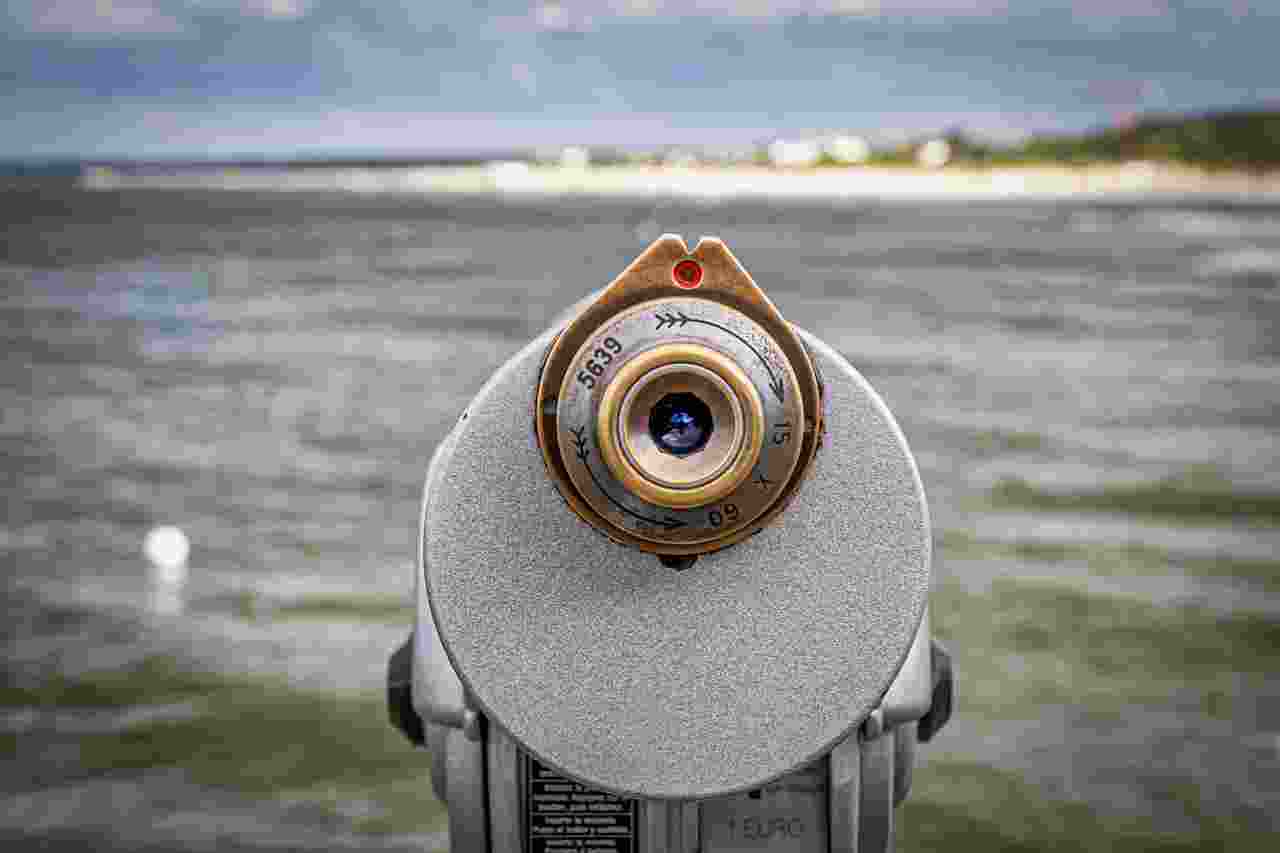*This post may contain affiliate links. This means we may make a commission if you purchase an item using one of our links*
Eyepieces are inherently very important equipment for any given telescope as they allow you to bring out not only the most power from any given system but also allow you to increase your wide field observing.
They’re not always necessary if you just want to look at the moon or even use your telescope as a make shift spotting scope however, if you’re someone who wants to see planets and other moons within our solar systems, a good quality eyepiece is always worth looking into.
In this list I’ll go over some of the best eyepieces you can find so, if you’ve maybe got a low quality item with your device or if you’re looking to upgrade, this article will give you a rough idea on where to start.
The Reasons Why You Should Invest In Eyepieces
Table of Contents
When you purchase a telescope, there’s a good chance it’ll come with 2 eyepieces, one 25mm one and a 10mm piece. The reason why eyepieces are useful is because through them you’ll be able to observe entities that are much farther away and essentially be able to utilise the maximum power that your telescope can produce.
However, not all eyepieces are made equal. Much like telescopes, eyepieces that have the same focal length does not guarantee that the viewing experience will be equal in quality. Whether it be the image quality, the comfort of your eye area and even the field of view.
I wouldn’t say that it’s absolutely necessary to spend a lot to get decent eyepieces that produce a solid viewing experience however, in order to maximise the potential of a telescope, a good quality eyepiece is imperative. That’s why in this list I’ll be going over some of the best eyepieces you can buy today and ultimately improve your star gazing experience.
1. Plossls Eyepieces
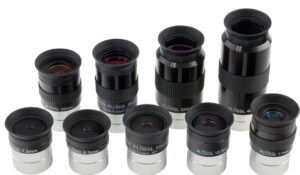
These are probably the most common eyepieces you’ll find in the market today as they’re compatible with pretty much every telescope out there.
They are helpful for achieving sharp imagery but, all in all they come in the box for a reason. The 50 to 52 degree variants are wide enough to view pretty much everything and the majority of different brands from meade, Celestron, orion all produce decent Plossl eyepieces.
These eyepieces in the end of the day are budget oriented therefore, they definitely will not produce the highest quality experience for most.
Therefore, it does make sense that the experience, in terms of comfort, does suffer at focal lengths of less than 12 mm, where the eye relief can be little too short for individuals wearing glasses.
In situations like that, I’d suggest staying with the longer focal lengths and using a Barlow to achieve higher magnifications in instead.
All in all, these are great budget eyepieces and you can’t really go wrong with them provided you aren’t overly enthusiastic about their power.
Click Here To Check The Pricing On Plossl Eyepieces
2. Agena Astro Starguider Dual ED
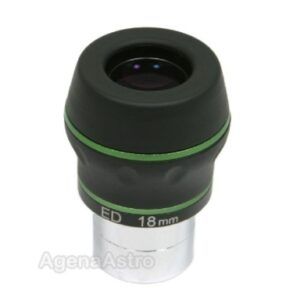
The Agena eyepiece is a great eyepiece for what it offers, being moderately wide angled at 60 degrees whilst also maintaining more comfort than plossl’s shorter focal length offerings.
The Agena is also a more budget oriented piece but this does not imply that users of these have not praised them for the quality the have at its price range. The Agena Astro is said have images that are sharp, have high contrast whilst also using good quality ED glass for the lens.
Therefore, the Agena is actually regarded as a noticeable step up from plossl offerings according to customers so, if your budget isn’t too tight, you definitely will get a better overall eyepiece in the Agena over the eyepieces that comes with your telescope.
If you’re looking for better viewing experience overall, the Agena Astro Starguider Dual ED is worth looking into.
Click Here To Check The Pricing On Agena Astro Starguider Dual ED Eyepiece
3. Meade 5000 Ultra-Wide
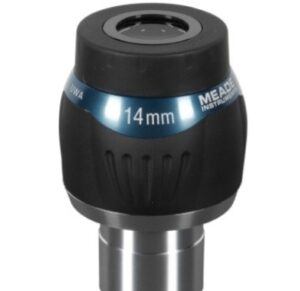
The meade ultra wide is a significantly more expensive eyepiece than the 2 variants mentioned above as it can cost as much as $150 to purchase one.
The meade 5000 comes in 2 different variations, a 1.25″ and a wider 2″ variant. This eyepiece comes in various sizes too, anywhere from 20mm to as small as 5.5mm. Its stand out feature is its extremely large 82 degree lens which makes for a very wide viewing experience.
The eyepiece is great even with scopes at the faster f/5 focal ratio, allowing users to experience sharp optimal performance with minimal visual issues, such as chromatic or spherical aberration.
Users of the eyepiece have found it to be very good considering the price you pay, the ghosting that cheaper eyepieces experience is minimal, the eye relief is also solid allowing users who wear glasses to have a fairly pleasant viewing experience.
The biggest concern for the Meade 5000 was actually the size of it, with dimensions and the size of the scope being 20.3 x 10.2 x 20.3 cm; 957 g. But besides that, considering how much it costs, the meade 5000 ultra wide is a great midrange eyepiece.
Click Here To Check Out The Meade 5000 Ultra-Wide Eyepiece
4. Orion 08890 1.25-Inch Premium Telescope Accessory Kit
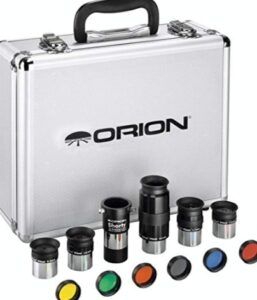
This is a kit full of multiple different sized eyepieces, made by Orion of course, that will set you back around $150 – $200.
Within the box you’ll receive 12 different accessories, 5 telescope eyepieces, 6 eyepiece filters, and a versatile Barlow lens. The eyepieces are Sirius Plossl telescope eyepieces with focal lengths of 40mm, 17mm, 10mm, 7.5mm, and 6.3mm. The eyepiece filters include 5 color planetary filters and a 13 percent transmission neutral-density Moon filter.
Lastly the Barlow lens is a 2x item which means it can double the magnification of the eyepieces.
This does mean that in comparison to a lot of the other eyepieces, the quality won’t be as good but, in terms of value, it’s not too bad. In fact if you’re purely after the value proposition this kit offers, Orion’s accessory kit isn’t one you can go wrong with.
Click Here To Check Out The Orion 08890 1.25-Inch Premium Telescope Accessory Kit
Click Here For Orion’s Official Pricing!
5. Celestron 8 To 24mm 1.25 Zoom Eyepiece
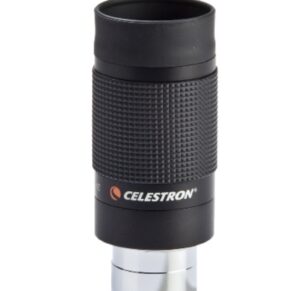
This eyepiece is kind of on the cusp of being an expensive item being around $70 – $100 and for that price you do get a pretty solid product.
The biggest selling point of the Celestron zoom is the fact you can increase or decrease the magnification of your telescope at a wide array of settings, from as large as 24mm to as small as 8mm so, you won’t need to go out and purchase items that are only limited to one rating.
As for how comfortable these eyepieces are, there don’t seem to be any complaints so it should be adequate. The image quality is regarded as being very solid with a decently wide 60 degrees at 8mm down to 40 degrees at the 24mm. The eyepiece isn’t huge too, weighing in at roughly 250 grams.
Of course the biggest benefit to buying a Celestron zoom is the fact you don’t need to lug around a bunch of different eyepieces every time you want a different magnification so, for the price and the fact most individuals who’ve used it really do like it, you honestly can’t go wrong with the Celestron zoom 8 – 24.
Click Here To Check Out The Celestron 8 To 24mm 1.25 Zoom Eyepiece
6. Tele Vue 13mm Ethos 2”/1.25” Eyepiece With 100 Degree Field Of Vie
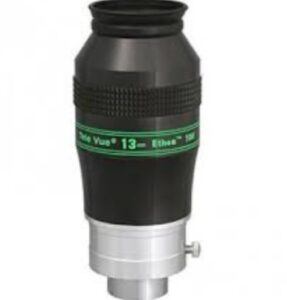
If you’re looking for a full on top of the line 13mm eyepiece, the Tele Vue is definitely one you should look at however, it does cost a staggering $550+ so, it’s something you should only buy if you’re fully invested in astronomy.
One of the biggest reasons for its huge price hike of course is the really large field of view that it has at 100 degrees. The 100 degree field of view literally allows for 50% more viewable space than an already large 82 degree so, that should be telling of how high end Ethos’ 13mm eyepiece is already.
Moreover, it’s designed in a manner where it has high contrast, comfortable eye relief and full field sharpness. It also allows you to have control of astigmatism, field curvature, lateral color, angular magnification distortion correction and low pupil sensitivity for daytime use.
At the price you’re paying for it, the Ethos will be a major step up, especially if you’re coming from plossl eyepiece and more or less everyone who has forked out for the eyepiece have found it to be well worth it. In fact it’s essentially the gold standard for mass produced eyepieces.
So, you definitely cannot go wrong with Ethos if you have the money to buy it.
Click Here To Check The Tele Vue 13mm Ethos Eyepiece
7. Explore Scientific 82 Degree Series
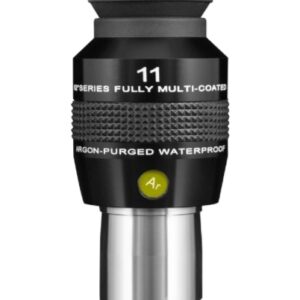
The explore Scientific 82 degrees is a very solid series and of course has a very high field of view at 82 degrees. This in turn means you’ll be able to get some very wide field views of space and be able to see some wonderful scenes of star clusters, nebulae etc.
As for how much it will cost you, this Explore Scientific will set you back around $150 so it’s not a device that most would be willing to spend. The price tag also puts it as a mid range eyepiece.
In terms of the user experience with this device, the majority of individuals who’ve used it genuinely liked it and found it to be great for systems with smaller focal ratio, particularly due to its larger field of view.
The only major problem users had with these specific eyepieces was the short eye relief for individuals who wear glasses when observing. But, besides that point there isn’t anything negative to be said about the 82 Degree Series.
Click Here To Check The Explore Scientific 82 Eyepiece
8. Celestron Eyepiece and Filter Kit
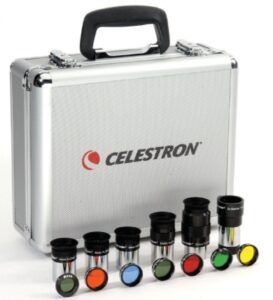
This is another one of these eyepiece kits, much like the orion one I went over previously on this list. The kit does provide fairly average quality eyepiece considering they’re plossl based however, if you want access to a large range of focal lengths which in turn will allow you to observe objects in multiple magnification levels, this $170+ kit may be worth it.
In the box you’ll receive 5 1.25″ eyepieces at following sizes, a 32 mm Plossl Eyepiece, 17 mm Plossl Eyepiece , 13 mm Plossl Eyepiece, 8 mm Plossl Eyepiece, 6 mm Plossl Eyepiece, a 2X Barlow Lens 1.25.
You also get 7 1.25″ filters which include the following, #80A Blue Filter, #58 Green Filter, #56 Light Green Filter, #25 Red Filter, #21 Orange Filter, #12 Yellow Filter, Moon Filter.
In terms of value for money, this Celestron kit is definitely up there but, in terms of quality it is at best above average so, these are points you’ll need to consider before investing in the kit.
Click Here To Check The Celestron Eyepiece and Filter Kit
9. Baader Hyperion 8-24 Zoom
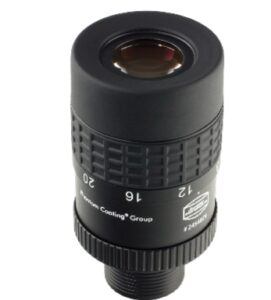
This is a more expensive zoom lens, setting you back around $250+ so, it’s definitely not something a beginner should invest in especially considering the Celestron zoom (or even the meade zoom) are all very competent eyepieces too however, if you want the best quality image and also don’t want to carry around multiple different eyepieces at different sizes, the Baader zoom is one device you should look at.
The field of view is quite large at 8mm reaching 68 degrees whilst at 24mm it’s 50 degrees, which isn’t the greatest but it’s still pretty solid.
In regards to the image quality, it’s really good, in fact it’d be hard to pinpoint any kind of fault with it, even when compared to the highest end eyepieces in the market so unless you’re a fanatic when it comes to the views you can see through an eyepiece, the Baader Hyperion definitely will not let you down.
Do be warned that, if you’re jumping to this eyepiece from the typical plossl eyepiece that comes with your average telescope, it will be a fair bit larger whilst also not being the lightest of items at its weight of 290 grams. Then again, considering the baader’s dimensions, it is still very light weight.
All in all, if you’re looking for a top of the line zoom eyepiece, this particular item is not one that you would go wrong with choosing.
Click Here To Check The Baader Hyperion 8-24 Zoom Eyepiece
Important Things You Should Know When Picking Out An Eyepiece
There are many elements that are important when looking at buying an eyepiece, from the obvious elements such as the price and focal length to the slightly more advanced elements such as the eye relief of a device to how wide the lens may be.
In this section I’ll cover these points so that you have a better idea of how you should go about purchasing an eyepiece.
The Different Price Ranges
As is the case with tech based equipment, the price will play a major part in the quality of the product you’ll receive after all it makes a ton of a sense that generally, the more you’re willing to invest in an eyepiece, the better the quality will be.
For under a $100, the eyepieces you get will be pretty solid however, do keep in mind that these are more budget oriented so, you will miss out on some nice additions. This may include how wide field the viewing experience will be, the detail may not be really really crisp, eye relief may not always be perfect and even aligning the eyepiece may be a bit of a pain.
However, this doesn’t mean you can’t find very useable and reliable eyepieces in this range, it’s just that they won’t be as premium as the more expensive variants.
Most eyepieces at the $100 – $250 range are, I guess you could say mid range eyepieces but, all in all as long as you don’t care about squeezing every little bit of width or detail, will perfect for the majority of amateur astronomers.
Most items within this range are great and just provide a polished user experience as a whole, some eyepieces provide something very close or in instances, an even better experience than the premium models.
$250+ is a price range that may mostly be paying for very established eyepiece brands and in general, the performance difference between these and a top of the line mid range eyepiece won’t be all too different.
You will be able to squeeze out a a bit more detail, contrast and wide field views with these eyepieces and objectively a $250+ device will be able to provide the best viewing experience however, whether or not that extra 10% of performance is worth it for your average consumer, I’d probably say no.
Then again, if you must have the best optical performance around, a premium eyepiece may very well be worth it.
The Diameter Of An Eyepiece
I’m sure you’ve seen that eyepieces generally tend to come in 2 different diameters right? A 1.25″ and a 2″ variant.
Although on paper it may seem like not to much of concern for most, these sizes are quite important because in some instances a telescope may not allow you to use a particular eyepiece unless you have an adaptor.
However, In todays telescope market, both of these sizes are industry standard meaning the large majority of telescopes will allow you to use both sizes.
The basic difference between the two is that the 2″ variants are actually designed so that it is easier for manufacturers to produce a wider field of view through. Do note that this does not always mean a 1.25″ eyepiece will have a smaller field of view than a 2″ model.
Lastly, the brand of an eyepiece doesn’t mean you won’t be able to use an eyepiece for a particular telescope. For example if you bought a Celestron eyepiece for a meade telescope, the only thing that would matter is the size of the eyepiece and not the brand.
This in turn will allow you to choose from a huge supply of eyepieces, provided they use the standardised diameters.
What Does The Focal Point Of An Eyepiece Mean?
The focal point of an eyepiece is used to determine how much power an eyepiece can generate from a telescope. In general terms, this means that an eyepiece with a smaller focal length will allow a telescope to magnify a lot more than an bigger focal length telescope but, there are a few more technicalities to this whole procedure.
Firstly, in order to effectively determine how much power a telescope can generate, you’d need to identify its aperture and focal length.
The aperture is what determines a telescopes maximum magnification potential which in turn will establish what eyepieces will be most useful for any given telescope.
For example let’s say a telescope has an aperture of 152mm and a focal length 1000mm.
What this would mean is that theoretically speaking this telescope would be able to provide a usable viewing experience at a max of 300x magnification (of course the numbers will likely be less in real world use). So in this case you’d only want to use an eyepiece that at most magnifies to 300x.
The focal length is what you’d use to determine how much magnification power a eyepiece will get out of a telescope. You may be asking so, how do you calculate the magnification of an eyepiece?
In simple terms, it’s by dividing the focal length of the telescope by the focal length of the eyepiece.
For example :
1000/25 = a magnification of 40x
1000/10 = a magnification of 100x
1000/4 = a magnification of 250x
As the numbers would suggest above, a smaller focal length eyepiece means the magnification of your telescope will increase. Furthermore, if you use a Barlow lens along with an eyepiece, you can further amplify the magnification.
A 2x Barlow lens will double the magnification. So the 40x magnification will be 80x or the 100x magnification will become 200x. A 3x Barlow lens will of course triple the magnification, the 40x will become 120x and the 100x will become 300x.
As for what eyepieces you should get, for telescopes that only accept 1.25″ eyepieces, a 32mm eyepiece would be ideal for the lower magnification wider field views whilst scopes that allow the use of 2″ eyepieces, a 40mm eyepiece would be better for wide field of view observing.
Do note that the focal length of an eyepiece will mostly be fixed (if you don’t opt for a zoom based eyepiece that is) therefore, you will need to switch them out on a regular basis in order to observe different elements of space at different magnifications.
How Is Eye Relief Established?
The eye relief of an eyepiece simply states how near or far you’ll need to be from the lens of the eye piece to see the full field of view. The lengths can vary, anywhere from 20 – 30mm to as low as 5mm, which is a distance a lot of individuals may find uncomfortable.
For individuals who wear glasses, it’s better for them to get eyepieces which have an eye relief of 17mm+ because trying to look through a 10mm lens with glasses probably isn’t going to result in the best experience for them.
What Does The Field Of View Of An Eyepiece Mean?
The field of view of an eyepiece basically means how narrow or wide the image through the eyepiece will be. This can range from a very narrow 30 degrees to a very wide 120 degrees.
The field of view that is listed on the features of an eyepiece is actually the apparent field view. This simply means that in the best case scenario you’d be able to achieve the maximum potential of the eyepiece when looking through a telescope however, the true field of view is determined in a slightly different manner.
The true field of view is determined through dividing the apparent field of the eyepiece by the magnification of the telescope.
Furthermore, keep in mind that 0.5 degrees is roughly equivalent to the width of a full moon so keep that as a reference in your head. Let’s say the telescope you’re using has a 1000mm focal length and an eyepiece that is 10mm.
Let’s also take 2 different apparent fields of view, 1 at 60 degrees and the other at 100 degrees.
The magnification for both eyepieces would be 100x. Now utilising the equation we’ll be able to determine the true field of view of the eyepiece.
60 degree apparent field of view /100x = a true field of view at 0.6 degrees (slightly wider than a full moon)
100 degree apparent field of view/100x = a true field of view at 1 degree (double the width of a full moon)
A larger field of view is most certainly desired for specific people who just want to gaze at a large portion of the universe at once but, it’s also a given these eyepieces will also cost a lot more, primarily due to the higher manufacturing costs.
Moreover, if you look at the stats, if you want the widest of views, ideally you’d want a to get a 30mm+ eyepiece with a larger apparent field of view.
The main reason why high quality wide field view eyepieces cost so much is because in order to reduce a large of portion of the distortion that generally come with wider eyepieces, especially for the smaller 1.25″ ones, it costs manufactures a lot more money.
So, for instances in which you want to observe the wider stratosphere, it’s always better to go for 2″ eyepieces because they’re just bigger and in turn manufacturers are able to produce a larger apparent field of view through them
How Will Your Telescopes Focal Ratio Determine Your Experience
The focal ratio of a telescope is also very important when it comes to shopping for an eyepiece because certain eyepieces may not be all that great for faster or slower telescopes.
Generally speaking, if you have a telescope that has a focal ratio of f/6 or more, most eyepieces should work just fine with them however, for systems with focal ratios of f/5 or even f/4, they will require you to purchase eyepieces that have specifically been corrected for these faster systems.
The reason why you’d want to find corrected eyepieces for the faster systems is because these devices tend to cause more visual issues such as aberrations in the image as you move from the center of the view toward the edges.
There are multiple forms of aberrations such as chromatic, spherical and a few more but, all you really need to know is that it’s really hard for the eyepiece to deliver a clean image to the edge for faster telescopes.
Conclusion
In conclusion all you need to know about eyepieces is that they’re very important tools and can very well determine how your experience with your telescope may go.
But, there’s obviously a ton of factors to consider when purchasing a device. Hopefully this article has helped you out ever so slightly and provided you with a solid guideline on how you should go about purchasing an eyepiece for your telescope today!
If you’re still thinking about purchasing a telescope, check this article out for some help.
If you found the article helpful, please don’t hesitate to share it with other as it would help us out a lot!
Thanks for reading
Amhil

